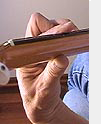Playing the Guitar - Introduction
The only way to become proficient on the guitar is to play as often as you can. The word 'practice' sometimes makes it seem like work, so it's better just to call it 'playing' ...▼
Once you know a little bit about how music is structured and where to find it on the fretboard, you must get those strings vibrating to make music. This, of course, means coordinating both hands. The fretboard hand must be holding the strings down firmly to allow them to vibrate, and the picking hand must attack the strings cleanly also, to prevent unwanted notes from clouding the sound. This may take a little while to achieve, and practice is the only way to get there. Your fingertips will hurt for a little while, as your calluses build up, but soon enough you won't feel any discomfort. Make sure you play at least a little each day to maintain the insensitivity.
The fretboard hand will also need some time to feel comfortable with some of the chord shapes, some of which require spreading the fingers out quite a bit, and changing from one chord to another seems impossible when you first start playing. Don't be discouraged, practice will make perfect.

To get the best leverage, power and control over the fretboard hand, try to make it a habit early on to keep the thumb as close to the middle of the back of the neck as possible. It should line up with your index finger as if you're taking the neck's pulse. It's a firm but relaxed pressure. You'll find if you keep the thumb and index finger lined up, the other three fingers will be able to work independently. As your hand moves, this thumb/index combo moves with it.
Your elbow should be dropped, everything should be relaxed. It's very easy for the shoulders to tense up ... try your best to keep everything relaxed and to make it a habit.
Strings can be manipulated in countless ways to extract the music: they can be pushed sideways to 'bend' notes up in pitch; they can be 'hammered on' and 'pulled off' to get from one note to another; strummed; plucked and picked; they can be muted to muffle the ringing; they can be slid up or down, to get from one note to another; they can be jiggled back and forth to make the note wobble in pitch, a technique called 'vibrato'; they can be slid upon using a metal tube, known as 'slide guitar' (my specialty); they can be lightly touched at specific points to create 'harmonics' ... the list goes on. These various techniques, together, create a player's distinctive trademark 'sound'. They all come with time — lots of it — but eventually become second nature.
In my Guitar and Music Primer, I take a good look at all the main techniques. Many of them are very intuitive and don't really require huge amounts of skill to perfect; others are much trickier and will take longer to master. All will require constant practice. Don't feel that you need to learn everything I show in the videos. They're not lessons so much as demos. I did, however, track all the fretboard action on the animated virtual fretboard just in case something does jump out at you that you want to learn. There are many aspects to playing the guitar, but the main thing to remember is to HAVE FUN!

Join Our Free Trial
Get started today before this once in a lifetime opportunity expires.
